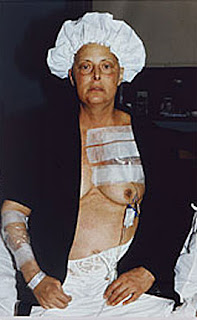Tuesday, October 30, 2012
Tuesday, October 23, 2012
MAK
Post your thoughts and ideas here for your performance. Explore the topic of women's reproductive rights here...
The End Group
Please continue the discussion here. Brainstorm. Keep pushing that idea of how to get people to experience creativity in their daily lives. Keep the discussion going here...
AAAJ
Post your discussion topics here for your discussion on the performance against human trafficking.
Monday, October 22, 2012
Sunday, October 21, 2012
Tuesday, October 16, 2012
las muertas de juárez
Hannah Wilke, SOS, 1974.
Hannah Wilke, Intra Venus, 1992-1993.
Regina José Galindo, Recorte por la línea (Cut Through the Line), 2005.
Sunday, October 14, 2012
Monday, October 8, 2012
A "Columbus Day" share, from Howard Zinn
"Arawak men and women, naked, tawny, and full of wonder, emerged from their villages onto the island's beaches and swam out to get a closer look at the strange big boat. When Columbus and his sailors came ashore, carrying swords, speaking oddly, the Arawaks ran to greet them, brought them food, water, gifts. He later wrote of this in his log:
'They ... brought us parrots and balls of cotton and spears and many other things, which they exchanged for the glass beads and hawks' bells. They willingly traded everything they owned... . They were well-built, with good bodies and handsome features.... They do not bear arms, and do not know them, for I showed them a sword, they took it by the edge and cut themselves out of ignorance. They have no iron. Their spears are made of cane... . They would make fine servants.... With fifty men we could subjugate them all and make them do whatever we want.'
…The Indians, Columbus reported, 'are so naive and so free with their possessions that no one who has not witnessed them would believe it. When you ask for something they have, they never say no. To the contrary, they offer to share with anyone….' He concluded his report by asking for a little help from their Majesties, and in return he would bring them from his next voyage 'as much gold as they need ... and as many slaves as they ask.' "
- Howard Zinn, A People's History of the United States
Sunday, October 7, 2012
Food for Thought
Food for Thought is a research-as-art performative component to a larger work conceived of by a collective of students in the Department of Visual Arts at California State University Fullerton, and comes out of the collective's study of social practice art in general and, more specifically, their study of performance in Mexico and Central America in a seminar taught in the fall of 2012. On a sunny afternoon in early October, students gathered, in a shaded quad in front of the Humanities Building of the university, to trade their homemade baked goods for their fellow students’ thoughts on art, performance, and their larger concerns about their place in the world. Volunteers filled out written surveys and some agreed to be interviewed on camera. The action was documented with photographs and videos. Upcoming events include processing the data, followed by an analysis, and, eventually, decision-making regarding the next step to be taken in this larger performative project.
Food for Thought Results
Saturday, October 6, 2012
Subscribe to:
Comments (Atom)
















